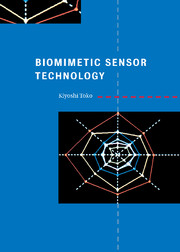5 - Odor sensors
Published online by Cambridge University Press: 23 October 2009
Summary
Types of odor sensor
An odor-sensing system is required in various fields such as the food, drink, cosmetics and environmental industries. Human sensory evaluations are often affected by physical and mental conditions. Consequently, development of an odor-sensing system to provide an objective, quantitative estimate is necessary.
Detailed molecular components in gas can be analyzed using conventional gas chromatography. However, it must be emphasized that even if we detect the molecular components, we cannot identify the odor directly. Moreover, real-time measurement is not easy as this method usually takes a few hours.
The sense of smell involves receiving chemical substances, as in the case of taste. The noticeable property is the diversity of the sensitivity and selectivity. Dogs have much greater sensitivity than humans by a factor of 106–108, as shown in Table 5.1. Insects have extremely high selectivity and sensitivity to one particular molecule, known as a pheromone, which binds to one type of olfactory cell. Experts in the cosmetics industries can also detect one kind of flavor (presumably originating from one type or several types of molecule) among several thousands of mixed flavors. In our daily life, however, we comprehensively express the quality of odor of foodstuffs, which originates from many kinds of chemical molecule, when we take dinner, for example. The sense of smell has two opposite properties. One is the recognition of odor without separating the gas producing the odor into its single chemical components.
- Type
- Chapter
- Information
- Biomimetic Sensor Technology , pp. 92 - 112Publisher: Cambridge University PressPrint publication year: 2000
- 1
- Cited by

